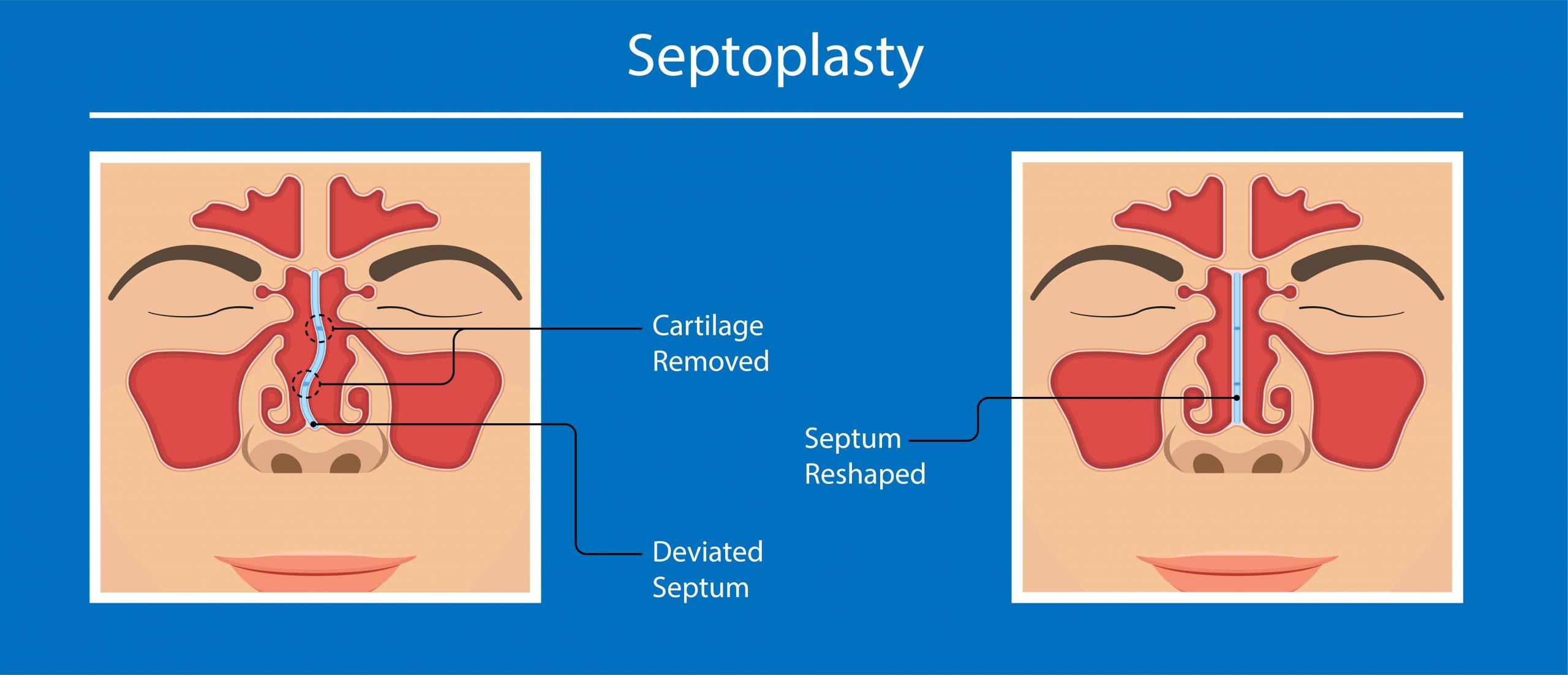Septoplasty – The procedure of Deviated Septum Correction
Septoplasty is a procedure that involves nasal septum correction by trimming, repositioning or replacing cartilage, bone or may be both. It intends to rectify a crooked or displaced septum, which is the wall that divides the two nasal passages. During this procedure, the surgeons reposition the displaced bone and cartilage in the middle. They shift the septum towards one side, which may reduce breathing difficulties and reduce the air force due to blockage in the airway. During the procedure, the surgeon may remove or cut a few parts of the nasal septum before replacing it in the central position.
The reason for Septum correction
A slightly deviated septum is common but if the deviation is severe, it can block one side of the nose, which can reduce the airflow, hence leading to breathing difficulty. The extra exposure due to deviated septum will cause it to dry and sometimes it may result in crusting or bleeding. Septoplasty helps straighten the nasal septum by replacement, reposition or by trimming cartilage, bone or both. If you experience any such symptoms, you may consider septoplasty and consult your surgeon for the same.

Are you a good candidate for Septoplasty?
Septoplasty is a recommended treatment to mend deviated septum and alleviate breathing difficulties. Consult your physician about the treatment options and finalize if you need a surgery or not.
You might be an ideal candidate for Septoplasty if:
You have a deviated septum that is causing you breathing issues
You are snoring too much and it is disturbing your sleep
You are a non-smoker.
Find a Plastic Surgeon in Your Area
Find Top Surgeons in India by Procedure
Find the Cost of a Procedure
Before you set yourself for surgery, make sure to know the benefits and risks about septoplasty, understand its preparations and recovery.
What to expect?
Before undergoing the procedure, the surgeon will review surgery details and try to find out answers to certain questions regarding the surgery.
He will ask you to get a few routine tests done, like blood test, X-ray or ECG
The surgeon would also ask questions regarding any recent medications you are on, or any allergies.
Even the anesthetist will come and explain the elements of anesthesia to the patient.
Preparations required for Septoplasty
Stop medications, if any: In a few cases, the doctor may ask the patient to stop certain medications 2 weeks prior to the surgery. These medications are blood thinners and this is to avoid excessive loss of blood during the procedure.
Consult if you are allergic to anesthesia: Generally, the treatment takes place after administering general anesthesia, which keeps the patient asleep all through the procedure. However, for a few cases the surgeon has to use local anesthesia to make the treatment area numb. The patient should tell the surgeon prior to the treatment if he has experienced an allergic reaction to anesthesia in the past.
Stop eating or drinking: The patient has to stop eating or drinking after midnight, the night prior the procedure, especially if he is undergoing general anesthesia. At least six hours of fasting is recommended as it helps prevent vomiting and choking if he feels nauseated from the anesthesia.

What is the procedure for Septoplasty?
During the Septoplasty procedure, the surgeon tries to straighten bent cartilage and bone in the septum. As the foremost step, the surgeon lifts the mucosa lining that covers the cartilage and bone. Then before repositioning the septum, he removes a few excessive portions. In case enlarged turbinates are causing blockage, the expert tries to shrink it with the help of radiofrequency reduction. In a few other cases, the surgeon might remove a portion of turbinate.
What to expect from Septoplasty recovery?
The patient can go home on the same day of the procedure after the anesthesia effect has worn out. The surgeon may place a packing inside your nose for support. If you undergo rhinoplasty during the same time then the nurse might also tie external bandages or a splint. The surgeon would remove the splints in his clinic a few days after the surgery. Some taping or bandages may stay longer for upto two to three weeks.
The swelling would gradually reduce within a few weeks. Full recovery will take a few months. Initially, the patient may experience pain and difficulty in breathing.
The physician would also instruct you for oral medications. He would guide you with the process of cleaning the wounded areas with the help of saline water in case of any debris or crust.
The results of Septoplasty
The results in a Septoplasty procedure are stable.
The septum reshapes: The septum slowly moves or reshapes over time. It takes 3-6 months for nasal tissues to settle down. For at least a year or more a few changes will keep occurring.
No more Breathing problems: In most cases, the surgery solves the breathing issue caused by the deviated septum. Although the level of improvement may vary from case to case.
Revised surgery if the symptoms prevail: In rare cases, the breathing trouble and other symptoms may continue even after the procedure. Hence, in such cases the patient will need to undergo a revision septoplasty to further amend the nose and septum.
Not expected to improve allergies: This procedure is a solution for mechanical blockage of the nasal passage and one should not expect to have improvement in the allergic symptoms like sneezing or running or congested nose.
Takeaway
Several non-surgical procedures also exist for nasal blockages, and are tried first for relief of nasal blockage and may help people sort their breathing troubles. However, if these have failed and or deviation is severe and you are a non-smoker and your health remains fit, Septoplasty might be required. It is a short procedure and you may get back home on the very same day itself. You should know that this will help for physical blockage and may not be effective for allergic conditions and you may have to undergo other procedures as well. You may consult a surgeon for these treatment options in detail.


